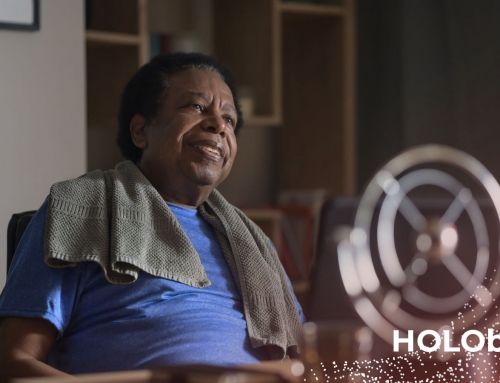We are proud and happy to share with you the findings of the Immersive Virtual Reality High-Intensity Aerobic Training to Slow Parkinson’s Disease study, showing improvements in several disease domains for patients diagnosed with mild-to-moderate Parkinson’s disease (stages I–III) when using HOLOFIT by Holodia VR cycling program.
What is Parkinson’s disease?
Parkinson’s disease is a movement disorder of the nervous system that worsens over time. The nervous system is a network of nerve cells that controls many parts of the body, including movement.
In Parkinson’s disease, nerve cells in the brain called neurons slowly break down or die. Many Parkinson’s disease symptoms are caused by a loss of neurons that produce a chemical messenger in the brain. This messenger is called dopamine.
- Around 10 million people have the condition worldwide – that’s less than one percent of the total population.
- Most people who get Parkinson’s are over 60, but one in ten are under 50. Slightly more men than women are affected.
- Parkinson’s is the fastest-growing neurological condition in the world – it is thought that the number of people with Parkinson’s will double to 20 million by the year 2050.
Can Parkinson’s be prevented?
Because the cause of Parkinson’s disease is not known, there are no proven ways to prevent it. Research shows that some factors may help protect against it. But scientists don’t know for sure. These factors include exercise. Aerobic exercise has been linked to a lower risk of Parkinson’s disease.
Intense exercise can be neuromodulatory and neuroprotective against Parkinson’s disease (PD). Indoor cycling is a good and safe option for this population, but some barriers (monotonous and repetitive environment, lack of monitoring, and an inability to compete with others) could limit its use. Immersive virtual reality (IVR) could be a possible solution to some of these drawbacks, increasing patient motivation and thus adherence to forced exercise programs using cycloergometers.
Using HOLOFIT VR cycling to help patients with Parkinson’s
Because the increase in patient motivation to exercise was identified as a prerequisite for getting the neuromodulatory and neuroprotective benefits in fighting Parkinson’s disease, the University of Vigo, Spain, decided to conduct a ReViPark program and use HOLOFIT VR cycling and its motivational content.
The ReViPark program combined the pedaling protocol of the HOLOFIT program with the Meta Quest II hardware. HoloFit software (available in the library at www.oculus.com, accessed on 10 December 2023), was synchronized with the smart cycloergometer allowed the patient to pedal through virtual environments, such as different European cities (London, Paris, Venice, etc.), natural landscapes, or sports competitions, while simultaneously performing small cognitive tasks.

A double-blind, randomized, controlled clinical trial was conducted to explore the feasibility and effects of the ReViPark program (high-intensity pedaling + IVR for 3 months with two sessions per week) on PD progression. In all, 52 people with PD were allocated to the ReViPark group (n = 30; 70.87 ± 6.67 years) and the smart cycloergometer group (n = 22; 70.59 ± 6.67 years).
This program was feasible, with no adverse effects (no significant Simulator Sickness Questionnaire symptoms and a low negative experience rating for the Game Experience Questionnaire (0.04/4)), no dropouts, high adherence, and good usability (System Usability Scale score of 82.90%).
The ReViPark group showed significant improvements in functionality, quality of life, and disease progression as measured by their balance, gait, and risk of falling (Timed Up and Go p = 0.028; Tinetti test p = 0.046), PDQ-39 scores (p = 0.035), and MDS-UPDRS scores (p = 0.001). This program is feasible and could lead to improvements in the functional parameters, quality of life, and symptomatology of the participants.
The preliminary results of this study show that patients diagnosed with mild-to-moderate Parkinson’s disease (stages I–III) can carry out a high-intensity pedaling-based physical exercise protocol and, moreover, accomplish this in an immersive virtual environment. Furthermore, the IVR software (HOLOFIT on www.oculus.com, accessed on 10 December 2023) and hardware proposed, when employed in combination with smart cycloergometers for the performance of multi-sensory stimulation therapies, are safe, tolerable, and easy to use for people with PD.
Moreover, the effects of the ReViPark program (high-intensity pedaling + IVR over a period of 3 months) led to improvements in several disease domains. In particular, functional parameters such as the strength of the lower train, dynamic balance, and gait are crucial aspects for avoiding falls in PD and ensuring functionality, quality of life, and the symptomatology of the participants as indicators of disease progression in terms of motor and non-motor aspects.
Future studies incorporating longer interventions and follow-up assessments are needed to corroborate these findings.
As for us at Holodia, this is the third major global health topic we have been engaged with, together with helping people with disabilities and working on improving the fitness of elderly users. We will continue supporting topics that contribute to our societies and help all people have healthier and happier lives.







